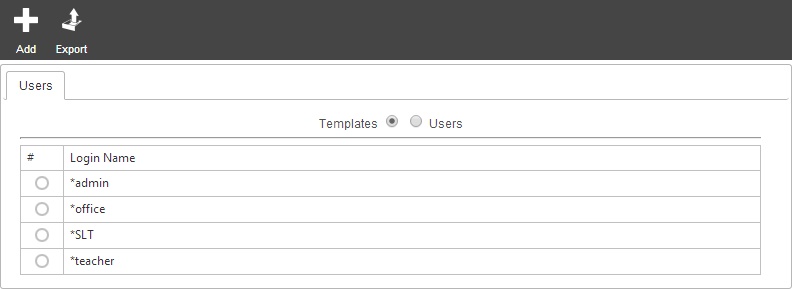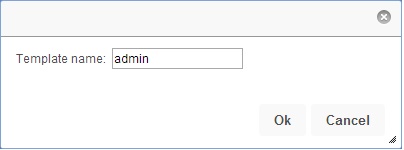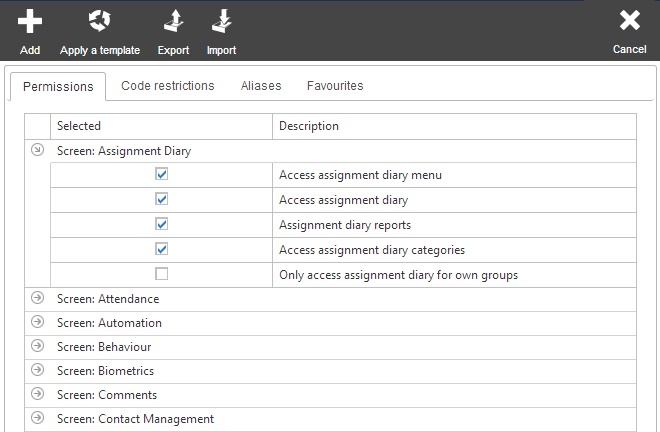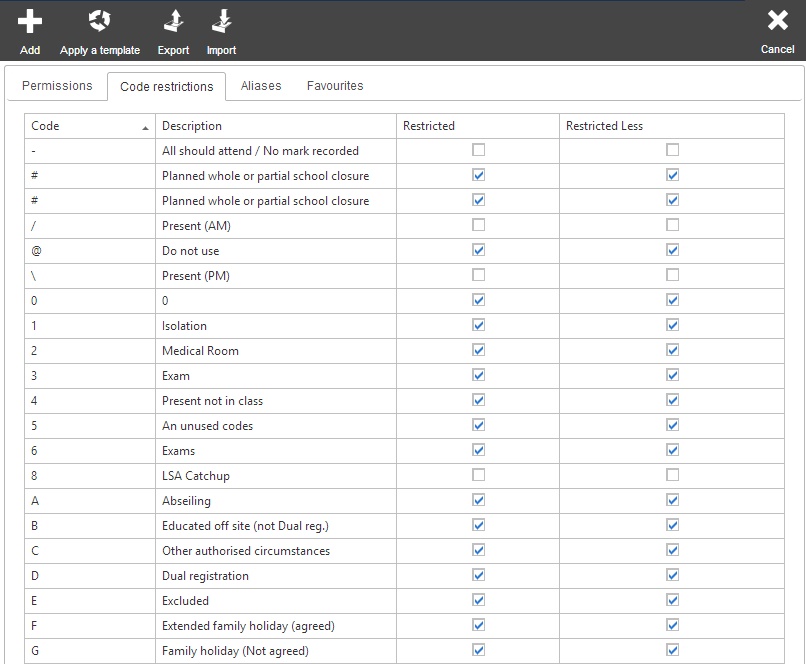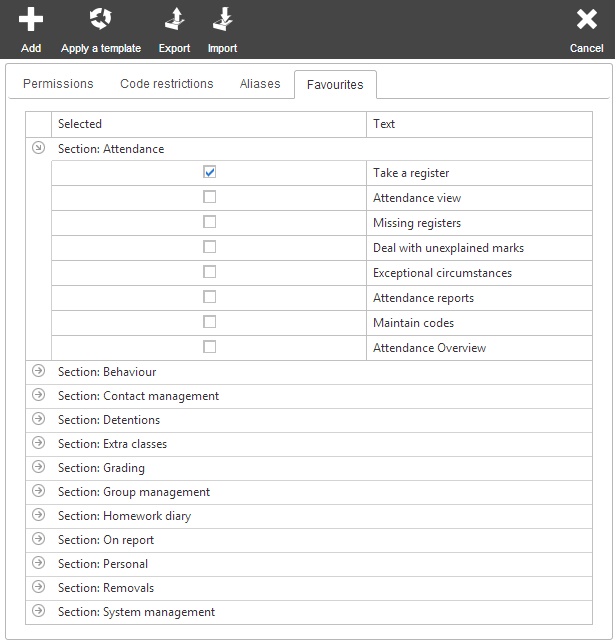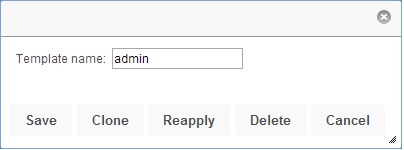Difference between revisions of "Permissions"
(→PARS) |
|||
| Line 552: | Line 552: | ||
* '''Deal with Unauthorised marks''' | * '''Deal with Unauthorised marks''' | ||
| − | ::Allows the user access to the "[[Deal with unexplained marks]]" section of Attendance on the [[PARS main menu]]. | + | ::Allows the user access to the "[[Deal with unexplained marks]]" section of Attendance on the [[PARS main menu]]. |
==PDA Manager== | ==PDA Manager== | ||
Revision as of 09:39, 7 July 2016
| Permissions required to access this module: | |
| Section: | |
| System Management | |
| Permission(s): | |
| Access PARS management options | |
| Access PARS permissions | |
PARS users access PARS using a SIMS .net username and password. PARS has a different set of permissions to SIMS, which are configured via System management. Most people in the school who do the same job are likely to have the same set of permissions so templates of permissions may be created and applied to selections of users as required.
In addition to their permissions, each user can be restricted in their ability to alias other users and enter certain attendance codes.
This page is accessed via:
PARS main menu > System management > Permissions
Contents
- 1 The permissions page
- 2 Creating a permission template
- 3 Managing permissions
- 4 List of permissions
- 4.1 Assignment Diary
- 4.2 Attendance
- 4.3 Automation
- 4.4 Behaviour
- 4.5 Biometrics
- 4.6 Comments
- 4.7 Contact Management
- 4.8 Detentions
- 4.9 Diary
- 4.10 Extra Classes
- 4.11 Grading
- 4.12 Group Manager
- 4.13 On report
- 4.14 PARS
- 4.15 PDA Manager
- 4.16 Personal
- 4.17 Pupil Info
- 4.18 Removals
- 4.19 Reviews
- 4.20 Signing In
- 4.21 System Management
- 4.22 Target
- 4.23 Tracking
The permissions page
Creating a permission template
First click the "Add" button from the top toolbar. You will first need to give your template a name. Give your template a name and then click "OK". You will then see your template appear in the list on the permissions page - select your template and click "Modify" from the top toolbar.
Permissions
This will open the permissions page, which has a list of every permission in PARS. You can turn permissions on by clicking the tickbox next to each permission.
You can either go through the list, ticking the permissions that you feel are required (see further down this page for a list of permissions and their functions) or you can import our suggested permissions templates:
(right click and choose "Save target as...")
To import a permissions template, click the "Import" button on the top toolbar. You can then browse to one of the files above, once it has been downloaded.
Code restrictions
By default, people entering Attendance marks via a register or an Attendance view screen can enter any code (with certain restrictions e.g "*" or "#"). It is possible to prevent users from using certain attendance codes. For example, most schools only want classroom teachers to enter Present, Late or Absent marks (\ / L N).
Click on the "Code restrictions" tab from the top toolbar. You will see a list of all available attendance codes in PARS. There are two columns that allow you to restrict access to attendance codes:
Restricted
- the attendance code cannot be used at all
Restricted lessons
- this attendance code can be used in sessions but not lessons.
Aliases
Aliasing is where a user view's another user's timetable and messages. This is usually preferable as it allows staff to see when other staff have non-contact time, easily take each other's registers and promote information sharing. However you may want some staff's timetable to be private i.e. the Headteacher's. for more information about aliasing, please see this page.
To restrict aliasing, first click the "Aliases" button from the top toolbar. You will see a list of all users. If none of the users are selected, then the people who you apply the permission template to will be able to alias anybody they like. However if you tick any users from this list, then the people using this permission template will only be able to alias the users that are selected here.
Favourites
Menu favourites can be set via User Permissions. Favourites allow users to quickly navigate to the features of PARS they use most. The favourites option shows every menu item in PARS with a checkbox. If the checkbox is ticked, then users will have quick access to that menu item, i.e. "Register", or "Add a behaviour incident".
Once you have finished configuring your permission template, click the "Save" button at the top-right.
Managing permissions
You should now apply your permissions templates to users. This can be done by going to the users tab, by clicking the radio button at the top of the page. Select any users that you want to apply the template to, then click "Modify" from the top toolbar.
You will come to a page showing all of the PARS permissions. Click the "Apply a template" button from the top toolbar and select the permissions template you want to apply.
Whenever you want to adjust the users' permissions, you should go back to the permissions tab and alter the template, not the individual's user permissions. Once you have edited the template, select it and click the "Manage" button from the top toolbar. A window will open - click the "Reapply" button to push the changes you have made out to all users who are on the template.
List of permissions
Given below are a full set of permissions found in PARS along with a brief explanation of each:
Assignment Diary
- Access Assignment Diary Menu
- Allows the user to access the Assignment Diary from the main PARS menu.
- Access Assignment Diary
- Allows the user to view and access the Assignment diary option under the main Assignment Diary menu.
- Assignment Diary reports
- Allows the user to generate and view Assignment Diary reports.
- Access Assignment Diary categories
- Allows the user to configure categories for use when adding assignments to the assignment diary.
- Only access Assignment Diary for own groups
- Allows the user to only access the Assignment Diary for Classes they are associated to.
Attendance
- Access Attendance Menu
- Allows the user to view and access the attendance menu from the main PARS menu. Users without this ability will still be able to take registers but will be unable to run attendance reports.
- Access Attendance View menu item
- Allows the user to view and access the Attendance view option under the main Attendance menu. Normally teachers should not have access to this as it is intended for editing existing marks rather than entering new ones.
- Allow amendments to marks in Attendance view
- Allows the user the ability to batch-enter attendance marks.
- Only enter attendance for own groups in Attendance view
- Allows the user to only batch-enter attendance marks for their own tutor group and any classes they teach. Unlike most permissions, this one is restrictive.
- Prompt for keeping mapped periods and their sessions in synchronisation in Attendance view
- Whenever an attendance mark in a mapped lesson period is altered on the Attendance view screen, the user will be asked if they want to have the session mark altered.
- Take registers for today
- Allows the user the ability to take registers for today's lessons or reg groups.
- Take registers for yesterday
- As above but will allow the user to "go back" a day.
- Take registers for any school day
- As above but will allow the user to take a register for any day within the school year.
- Only view registers for yesterday
- The user may only view registers taken the day before (as well as today's registers).
- Report on attendance
- Allows the user to generate and view attendance reports.
- Deal with missing registers
- Allows the user access to the "Missing registers" section of Attendance on the PARS main menu.
- Hide the hover over on the register screen
- With this box unticked, hovering over a pupil's name on a register will stop the pupil's name from being highlighted. This may be useful on machines with lower graphics capability or no graphics drivers.
- Hide student details hover over on the register screen
- The yellow "tool tip" containing student details (including their photo) will be hidden if this permission is ticked.
- Access Exceptional Circumstances
- Access the Exceptional circumstances menu item that allows groups of pupils to have a "Y" attendance entered for them over a period of time.
- Prevent user from being able to enter attendance comments
- Prevents the user from adding comments to a student's attendance record in attendance view.
- Show attendance comments on registers
- Allows the user to view attendance comments via their register.
- Hides the Mark All Present button from register screens
- Prevents user from being able to mark all students present with a single click when taking a register.
- User can edit Seating plans layouts created in PARS Connect
- Allows user to edit seating plans within PARS Connect.
Automation
- Access Automation Control
- Allows the user to view and access items in the Automation section on the PARS main menu.
- Setup automation jobs
- Allows the user to configure any existing automated jobs.
- Clear automation history
- Allows the user to delete the log of jobs already run.
Behaviour
- Access positive behaviour incidents
- The user can record and view good behaviour
- Access negative behaviour incidents
- The user can record and view bad behaviour
- Access neutral behaviour incidents
- The user can record and view events that are neither good nor bad
- Access cash in behaviour incidents
- The user is allowed to "cash in" behaviour points that have been awarded
- Only enter incidents for own groups
- The user can only record behavioural incidents for pupils that they teach.
- Only pick up own incident referrals
- The user can only view behavioural incidents that have been referred to them.
- Pick up external incident referrals
- The user can view behavioural incidents that have been referred to third parties.
- Report on incidents
- The user is able to access the various Behaviour reports available from the PARS main menu
- Configure behaviour schemes
- Allows access to the configure behaviour options on the PARS main menu
- Enter students onto the On Report group as a result of deleterious conduct
- Allows the user add pupils to an On report group.
- Add and modify behaviour incident designs
- Allows the user to create and edit behaviour slip templates using XSLT/XML transformations.
- Stops user changing the adjusted points
- Prevents the user from altering the number of points a merit or demerit is worth on the behaviour entry screen.
- User can refer people to a selected teacher
- The user is allowed to specify a teacher to refer behavioural incidents on to.
- User can refer people to a selected external contact
- The user is allowed to specify an external contact to refer behavioural incidents on to.
- Only incidents created by user will be shown on Edit Behaviour screen
- In Edit a behaviour incident the user will only be allowed to see behaviour incidents recorded by them.
- User can only delete incidents that they have recorded
- In Edit a behaviour incident the user will only be allowed to delete behaviour incidents recorded by them.
- Users can only edit incidents that they have recorded
- In Edit a behaviour incident the user will only be allowed to edit behaviour incidents recorded by them.
- Only enter behaviour incidents under own name
- This prevents the recorded by field being set to any other teacher's name in the behaviour entry screen.
- Display - Save and Add Another - button on behaviour entry screen
- This gives the option to save the current behaviour entry and add another without closing the behaviour entry screen.
- Allow user to access the Configuration Alerts Screen
- This gives users access to the 'Configure Alerts' screen.
- Allow the user to change the outcome where a ground is linked to a default outcome
- This allows the user to choose the outcome for a behaviour incident, regardless of whether or not the incident is linked to a default outcome.
- User can set behaviour incidents to private
- This allows the user to restrict who is able to view a behaviour incident they have recorded or edited.
- Ignore privacy status when loading incidents
- This allows users to view any behaviour incidents, regardless of whether they are set to private.
- Hide the Add a behaviour incident button from the PARS main menu
- This removes the option to add behaviour incidents via the main menu.
- Add incidents linked to colour coded ASM formula columns
- Allows you to give behaviour incidents based on the colours of grades taken from SIMS.
- Allow user to access Rule based behaviours
- Allows the user to access and configure Rule based behaviours
- Allow user to access House points
- Allows user to view, add, edit and delete house points.
- Allow user to add and remove House points
- Allows user to ADD and REMOVE house points.
- Allow user to true edit House points
- User can edit house points without leaving trace of their actions
- Allow user to fully delete House points
- User can delete house points without leavng trace of their actions
- Prevent user from changing the default house point applicability of an incident
- Allows the user to decide whether a behaviour incident should contribute to house points regardless of configuration to make certain incidents apply/not apply to house points by default.
- Allow user to create, edit and delete Custom Behaviour Reports
- Allows user the ability to create, edit and delete Custom Behaviour Reports.
Biometrics
- User can add people to a biometric datastore and link them to PARS
- If a biometric reader (e.g. a fingerprint scanner) is to be used to record attendance marks, the user will be able to add pupils to the biometric database and associate them with the pupil in PARS.
Comments
- Access comment bank
- The user is able to access the Comment bank when entering grade comments.
- Configure comment bank
- The user is able to add/remove comments from the Comment bank.
Contact Management
- Access Notices management section
- Allows the user the ability to create new (and delete existing) notices.
- Create a new notice
- Allows the user to create and send notices.
- Manage other peoples notices
- Allows the user to edit and delete notices not created by themself.
- Manage and remove System-originated notices
- Allows the user to edit and delete notices created automatically by PARS
- Manage and review external communications
- These include Email, Text messages (SMS), written letters and logged telephone conversations.
- Set up and modify a Text Messaging account
- Allows the user to access the "Configure SMS" section of the Contact management module on the PARS main menu
- Allow access to Contact management comment bank
- Allows the user access to the "message bank" section of the Contact management module.
- Report on contacts made
- Allows the user to run reports generated from Emails, Text messages (SMS) and written letters sent.
- Edit contacts notes made entries
- Allows a user to edit contact details that have been recorded either manually or automaticaly by PARS.
- Remove contacts made entries
- Allows the user to delete contacts details that have been recorded either manually or automatically by PARS.
- Create blank mail merge documents
- Use PARS to insert mail merge fields into a blank Microsoft Word document.
- Gives the user the ability to delete all notices on the system recorded before a selected date
- Allows the user to delete notices issued prior to a chosen date. This will delete notices belonging to all users, not an individual's notices only.
- Prevents user from sending emails
- Prevents the user from sending emails to external parties using PARS.
- Prevents user from sending SMS messages
- Prevents the user from sending text messages (SMS) to external parties using PARS.
- User can view external contacts set to private
- Allows user to see any external contacts that have been set to 'Private' in SIMS.
- Prevents user from creating instant notices on the manage contacts screen
- Prevents user from creating instant notices within the 'Manage Contacts' screen.
- User will receive notices as emails as well as notices
- Ensures user will receive notices as emails as well as receiving messages as notices.
Detentions
- Access to detentions section
- Allows the user to view the detention section of the PARS main menu.
- Allow user to mark pupil for detention
- The user can place a pupil on detention.
- Allow user to mark pupil for detention without linking to behaviour
- The user can record a detention without having to record an associated Behaviour item (e.g. merit or demerit).
- Force automatic scheduling when saving detentions
- When the detention is saved, it is scheduled for the next available timeslot. Timeslots can be chosen to be at least X number of days in advance, the value of X is set via Configure preferences.
- Allow user to edit and deal with pupil detentions
- The user can edit/delete and reschedule detentions.
- Take detention registers
- Allows the user to access and take detention registers.
- Report on detentions
- Gives the user access to the various Detention and Removal Reports. (See Detention reports and Removal reports)
- Access to detention slip printing
- Allows the user to print notification and permission slips, where required, for pupils who have been given a detention.
- Access to detentions configuration
- Allows the user to access and alter detention settings where they can configure detention time slots.
- Add and modify detention parental slip designs
- Allows the user to create and edit parental consent printed slip forms.
- Defaults users detentions to personal
- When a person records a detention, it is added to a personal register by default.
- Allow user to alter the force automatic scheduling date
- Automatic scheduling can be overridden by the user if necesssary.
- Display automatic scheduling summary
- A pop up will inform the user about the date and time of automatically scheduled detentions.
- Allow user to access rule based detentions.
- Allows the user to view the Rule based detentions section of the detentionsmenu.
- Allow user to modify rule based detentions rules.
- Allows the user to edit rules in Rule based detentions.
- User must schedule detention when saving (where automatic scheduling is not in effect)
- If this is ticked then the user cannot accept the detention until they have scheduled the detention. This only applies when automatic scheduling is not enabled.
- Allows user to bulk send detention related SMS messages
- This permission gives access to a feature called send SMS notifications.
- Only allow user to set detentions for themselves
- Ensures user can only set detentions that are personal to themselves.
- Only allow user to view, edit and delete own detentions
- Prevents user from viewing, editing or deleting any detentions that are not personal to themselves.
- Access to parental inform screen
- Allows user to access the 'Parental inform' screen.
- View personal detentions set by other users
- Allows user to view any personal detentions that have been created by other users.
- Allow recording of roomless personal detentions.
- If this permission is not enabled, users will not be able to issue a personal detention unless they also record which room that detention will take place in.
Diary
- Allow user to create diary entries when aliasing other users
- The user can create diary entries on other users' pages while aliasing them.
- Allow users to see Non-contact time as diary entries
- This will display all timetable periods on the homepage, including free periods.
- Imports Outlook calendar appointments
- This will automatically insert into the PARS homepage any entries the user has in their Microsoft Outlook calendar.
- Allows the user to create diary entries that are visible to all on their own diary
- This will give the user the option to export their diary page to an iCalendar file (.ics) suitable for importing into Microsoft Outlook.
- Shows tooltips when hovering over diary page entries
- A hover box is displayed when hovering over cells in the diary page.
- Shows the owner of non-editable diary items
- Permits system to display name of the owner of non-editable diary items to logged in user.
Extra Classes
- Access to Extra classes section
- Allows the user to access the extra classes menu.
- Allow user to add pupil to extra class
- Allows the user to edit register lists for extra classes.
- Take extra class registers
- Allows the user to access and take extra class registers.
- Report on extra class
- Allows access to extra class reports.
- Access to extra class configuration
- Allows the user to create and manage extra class timeslots.
- Defaults users extra classes to personal
- Ensures that extra classes created by logged in user are set to 'Personal' by default.
Grading
- Access grading
- Allows the user access to the grading section on the PARS main menu
- Enter grades
- Allows the user the general ability to enter grades.
- Access grade preview
- Allows teachers to preview existing grades and enter comments.
- Only enter grades for own groups
- Prevents user from entering grades for lessons they do not take.
- Grading Reports
- Allows the user to run the various grading reports that are available.
- Configure grading schemes
- Allows the user to create and edit grade schemes.
- Configure grading elements
- Allows the user to create and edit grade elements.
- Import/Export of grades
- Allows the user to access the Import/export grades module.
- Show photo instead of admission number
- The left hand column on each enter grades screen will contain the pupil's photo instead of their admission number.
- Override the closed status of a column
- Grades may be entered into any grade column at any time, including columns that are greyed out.
- Access grade authorisation
- Allows user to access the 'Grade Authorisation' menu item.
- Allow user to batch enter comments
- Allows user to batch enter comments within the 'Grade entry' screen.
- Allow user to create, edit and delete Custom Grading Reports
- Allows a user to create, edit and delete Custom Grading Reports.
- Allow users to copy grade entry columns on the Grade Entry screen
- Allows users to copy grade data in columns to other columns in the 'Grade Entry' screen.
- Show attendance percentage on entry screen
- Displays students attendance percentage within the 'Grade entry' screen.
- Access form based grades
- Allows user to access 'Form based' grades.
- Access Key Indicator configurations
- Allows user to access configurable options for 'Key Indicators'.
Group Manager
- Access group management
- Allows the user access to the group manager section on the PARS main menu and manage groups.
- Delete and repopulate the all years group
- Use this to rebuild the All Years group when the Automation Module is not running.
On report
- Access to On report section
- Allows the user to access menu items in the On report section of the PARS main menu.
- Manage students on report
- Allows the user to add, edit and remove pupils on report.
- On report reports
- Access a selection of reports relating to pupils On report.
- Configure on report elements
- Allows access to the On Report grade element option, user may create new and edit existing "on report" grade elements
- Add/Edit/Delete PARS on report groups
- User has access to options allowing configuration of On report groups.
PARS
- MDI Select
- User is able to choose whether or not to use the MDI interface. The MDI interface allows multiple difference report / batch entry etc screens to be open simultaneously within PARS. With MDI switched off, every time a new report etc is run the old one is removed and has to be re-run in order to view it again. Some users with MDI switched on may experience a degradation in performance where multiple windows have been left open.
- MDI Always
- User is forced to use the MDI interface
- Always default to portrait for printing
- When reports are created and sent to the printer, they must be recreated if the user switches between portrait and landscape. With this option either ticked or unticked as required, time may be saved in this process.
- Allows users to change current attendance year
- If a user needs to go back and check data from previous years, this option will show the drop-down Academic Year list on the PARS diary page.
- Allows users to import templates from the web
- The user has the ability to download pre-configured grading configuration, student review and slip design templates.
- Allows users to switch off sounds in PARS
- Used where sounds are available and may cause a distraction.
- Shows standard Windows control box
- Displays the standard Windows Minimise, Maximise and Close buttons at the top right of the screen
- Hides the PARS Alert button
- Displays or Hides the Emergency Alert button in PARS
- Always default to BW printing
- Ensures that when printing from PARS, black and white print is selected by default
- Use own email address as email reply address if available
- Will check to see if logged in users email address can be used as email reply address when sending emails from PARS
NOTE - If 'OFF' the usual 'From' address will be used.
If 'ON' and the user does not have a work email address in SIMS, the usual 'From' address will be used.
If it is 'ON' and the user has a work email address in SIMS, that address will be used.
- Add own name to the sender of the email if available
- Will check to see if logged in users own name is available to be used as 'Sender' for emails sent from PARS
- Use own email address as SMS reply address if available
- Will check to see if logged in users email address is available to be used as reply address for SMS sent from PARS
- Access medical information
- Allows user to access medical information from within PARS
- Deal with Unauthorised marks
- Allows the user access to the "Deal with unexplained marks" section of Attendance on the PARS main menu.
PDA Manager
- Access to offline management for PDAs screen
- Allows user to access 'Offline management for PDAs' screen.
Personal
- Access to Personal section
- Allows user to access 'Personal' menu item.
- Access to Personal reports
- Allows user to access 'Personal' reports within the 'Personal' menu item.
Pupil Info
- See the dashboard tab on the pupil information screen
- Access the dashboard feature via the Pupil information screen.
- See the SIMS documents tab on the pupil information screen
- Access documents held on the SIMS document server via the Pupil information screen.
- Allow user to upload files to the SIMS document server
- Gives the user permission to upload files to the SIMS document server.
- Include Confidential documents on the SIMS Documents tab
- Enables the system to include 'Confidential' documents on the 'SIMS Documents' tab.
- See the SEN tab on the pupil information screen
- Access special needs information via the Pupil information screen.
- See the IEP tab on the pupil information screen
- Access Individual Education Plan (IEP) information via the Pupil information screen.
- See the time table tab on the pupil information screen
- Access the pupil's timetable via the Pupil information screen.
- See the contact tab on the pupil information screen
- Access external contact information via the Pupil information screen.
- See Behaviour information on the pupil info screen
- If this permission is ticked then users will not be able to see the behaviour tab in the Pupil information screen.
- See the lesson tab on the pupil information screen
- Access lesson information via the Pupil information screen.
- See the detentions tab on the pupil information screen
- Access detention information via the Pupil information screen.
- See the on report tab on the pupil information screen
- Access on report information via the Pupil information screen.
- See the removals tab on the pupil information screen
- Access removals information via the Pupil information screen.
- See the extras tab on the pupil information screen
- Access parental consent information via the Pupil information screen.
- Allow user to add and edit PARS IEPs
- Allows the user to add and edit IEPs within PARS. Users without this permissions will still be able to view IEPs, but they will not be able to add their own, or edit existing IEPs.
- Allow user to delete PARS IEPs
- Permits user to delete PARS IEPs.
Removals
- Access to removals section
- Displays the Removals item on the PARS main menu.
- Allow user to mark pupil for removals
- The user has the ability to request one or more Removals.
- Allow users to mark pupils for removals without linking to behaviour
- Allows users to mark pupils for removals without linking to a behaviour incident.
- Allow user to edit and deal with pupil removals
- The user can alter existing removal requests and place existing requests into removal timeslots.
- Take removals registers
- Gives the user access to the Take removals registers item on the PARS main menu
- Report on removals
- The user can access information about Removals via the Removal reports item on the PARS main menu
- Access to removal slip printing
- Allows user to access removal slip printing functionality.
- Access to removals configuration
- The user can create, edit, schedule and delete removal timeslots.
- Add and modify removal parental consent slip designs
- Allows user to add and modify, removal parental consent slip designs in PARS.
Reviews
- Access student reviews
- Gives the user access to the student reviews item on the PARS main menu.
- Generate and output student reviews
- The user can create student reviews using existing review designs.
- Add and modify student review designs
- The user can create and edit Student review designs.
- Allow users to upload reviews to SIMS
- A copy of the review can be uploaded to the SIMS Document Server and linked to the student.
- Allows user to add, edit and delete review periods
- The user can create and edit student review periods.
Signing In
- Access Signing in
- The user has access to the Signing in module and is able to sign pupils in or out.
- Setup Signing in
- The user can assign certain preferences to Signing in groups that have been created via the group manager.
- Signing in reports
- The user can access signing in reports.
System Management
- Access PARS management options
- Gives the user access to the System management item on the PARS main menu
- Access PARS permissions
- The user can access the permissions module allowing individual users' permissions to be altered.
- Access PARS preferences
- The user can access the preferences module allowing global preferences to be edited.
- Configure proxy settings
- The user can enter details of a proxy server that may be needed for a PARS workstation to access the internet.
- Access PARS repair console
- The user is able to enter SQL statements via the Repair console if advised to by the PARS Online Helpdesk.
- Access SQL tune-up
- The SQL Tune up option allows certain SQL performance-related settings to be altered.
- Kill MS SQL processes
- When updating SIMS it may be necessary to kick all PARS users out of the database. This can only be done via PARS .net, not PARS Connect.
- Manage programs that can be launched from within PARS
- Allows the user to add additional items to the custom launch menu item.
- Configure external status parameters
- Gives access to the configure external status menu item allowing swipe card readers etc to be configured.
- Manage help desk tickets
- The user can review and manage existing tickets and post automatic tickets to the PARS Online Helpdesk.
- Management reports
- The user has access to the various Management reports that can be used to troubleshoot PARS.
- Maintain attendance codes
- This gives access to the Maintain codes feature under System management.
- User can imports iCalender files
- Allows user functionality that enables the import of iCalender files into PARS.
- Gives access to the SQL debugger
- Allows user access and use of SQL debugger in PARS.
- Gives access to tools for bulk deletion of data
- Allows user to access functionality designed for bulk deletion of data.
- Gives access to subject leader configuration
- Allows user to access configurable options that allow for the specification of subject leaders.
- Gives access to the bulk importing of emails
- Allows the user to access the bulk import emails page.
Target
- Add link to Target
- Enables link to Target Software.
Tracking
- Access pupil graphing
- The user has access to the Pupil Graphing menu item.
- Access pupil tracking
- The user can create and view Pupil tracking graphs.
- Access behaviour graphing
- The user can create and view Behaviour graphs.
- Access to the 'School information' button
- Allows user to access functionality that displays school information.
